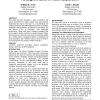536 search results - page 36 / 108 » Computing Spatial Similarity by Games |
CHI
2010
ACM
14 years 3 months ago
2010
ACM
A group of friends visiting a crowded and noisy music festival is an example of a situation where knowing the location of other people is important, but where external factors, su...
GROUP
2007
ACM
14 years 2 months ago
2007
ACM
Networked games can provide groupware developers with important lessons in how to deal with real-world networking issues such as latency, limited bandwidth and packet loss. Games ...
EICS
2009
ACM
14 years 5 months ago
2009
ACM
Interactive computing systems frequently use pointing as an input modality, while also supporting other forms of input such as alphanumeric, voice, gesture, and force. We focus on...
CANDC
2011
ACM
12 years 11 months ago
2011
ACM
This paper discusses Paradigm, a game of intuition and pattern exploration. We offer a sample case study aimed at illustrating the game’s relevance as a microdomain for studying...
ECCV
2006
Springer
14 years 2 months ago
2006
Springer
Abstract. In this paper, we describe an unsupervised learning framework to segment a scene into semantic regions and to build semantic scene models from longterm observations of mo...


